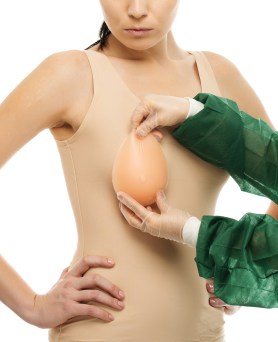
Breasts are largely made up of fat cells so, as you lose body fat and build lean muscle, your breasts may lose some of their fullness, which can affect self-confidence.
When considering implants, athletic women may worry that breast implants will interfere with their active lifestyle.
Fortunately, breast augmentation surgery has advanced significantly in recent years. Options available and techniques used are vastly superior to those used twenty years ago and ensure that your tailor-made breasts have little or no negative impact on sports performance.
Pros and cons of implants
Breast enlargement is one of the most popular plastic surgery procedures worldwide. Benefits are both aesthetic and psychological, as you’re likely to feel more self-confident, sexy and feminine. Clothes will fit better and your sex life may even improve.
But it’s not a cheap fix. Nor is it risk-free. An average implant costs in the region of R30,000 – R40,000 and it is associated with a number of risks. Although not life-threatening, these can be painful and unsightly and often require corrective surgery. The most common risks are:
- Capsular contracture – this is scar tissue that forms around the implant over time and makes the breast look and feel tight or hard. There’s a 5% chance per breast of this happening.
- Deflation in the case of saline implants.
- Implant casing may become compromised.
- Bleeding and/or infection.
- Change in sensitivity of the nipples or breast skin.
Accepting these risks as possibly being a consequence of your new shapely body is one of the compromises that you’ll need to make when deciding on a breast augmentation. On a lighter note, there’s plenty of scientific evidence indicating that implants don’t cause breast cancer, nor should they prevent you from breastfeeding.
Sizing it up

For women with low body fat, choosing the right size is paramount to enhancing your body’s contours. Factors such as your build, amount of breast tissue and the shape of your breasts all play a part in determining how large you should go. “The aim is to try to ascertain the most appropriate implant for individuals,” says Cape Town plastic surgeon Dr Paul Skoll. “I do this by taking a number of measurements of the chest and breasts, which provides a guideline in determining the right size of the implant.”
If you’re not entirely convinced by what the surgeon’s measurements suggest, ask to try on implant ‘sizers’. These testers fit inside a bra and give a reasonable guide to how the end result will look. Sizes vary from very small (100ml) to very large (800ml), with a conservative option ranging between 160 to 250ml. They also vary in projection. The choice lies between low, medium or high profile, depending on your anatomy, and how ‘perky’ you would like your breasts to be.
Reasonably sized implants won’t affect your training performance. Johannesburg-based personal trainer Sune Olivier from Lifestyle Experts currently has two women on her advanced course who recently had implants. “They cycle and do extensive weight training and their breast implants don’t influence their exercise routines at all.”
However, deciding on a size too large for your frame could cause the same discomfort natural breasts the same size would, possibly even more. Professional sportswomen have been known to have breast reductions to improve their performance, such as Romanian tennis champion Simona Halep. In 2009 she had her size 34DD breasts reduced. She complained that the extra weight on her chest was uncomfortable and caused severe back pain, which affected her performance on the court.
Location, location, location

Placement of implants is particularly important for women focused on muscle development and this depends largely on how much existing breast tissue you already have. For the serious sportswoman with very developed pectoral muscles this is a particularly important decision that needs to be made in conjunction with your surgeon.
The two options for placement are partially under the pectoral muscle (sub-pectoral or dual plane) or over the muscle and under the mammary glands (sub-glandular). When placement in front of the muscle is considered appropriate, some surgeons use the sub-fascial approach. This involves placing the implant over the muscle but under the fibrous sheet or ‘fascia’ that covers the muscle. This fascia provides added support for the implant and prevents the ‘stuck on’ look.
Dr. Skoll measures pinch thickness to help decide on implant placement. “The more subcutaneous tissue, the more likely that the implant will be placed sub-fascially. On the other hand, the less subcutaneous tissue surrounding the breast, such as in very thin patients with low body fat, the more likely that the suggested placement will be dual plane.
If your focus on muscle tone is not that extreme, don’t stress. According to two different studies in the USA, it’s very unlikely that sub-pectoral/dual plane implants will affect pectoral muscle function or cause loss of upper-extremity strength performance in the average active woman.
Gaining access
Like with most surgery, breast augmentation will leave a scar. The size and visibility thereof depends on where it’s located and how well your body heals.
Incisions can be made in one of three places: In the breast fold (inframammary), around the nipple (periareolar) or under the arm (transaxillary). The first option is used most often as it offers the surgeon the best control over the operating area and the breast hides scarring. It also enables more accuracy with placement and prevents unnatural contours such as ‘top heavy’ breasts or ‘bottoming out’, which may require corrective surgery.
Placement via the nipple may affect breastfeeding because glandular tissue may be damaged during surgery. The transaxillary approach won’t affect this nor scar the breasts, but it may leave a scar that’s visible when wearing a bikini or gym clothes. There’s also a higher incidence of ‘high riding’ or asymmetrically placed implants with this method.
